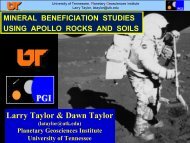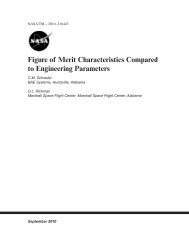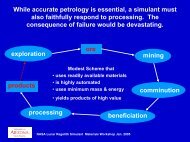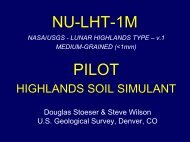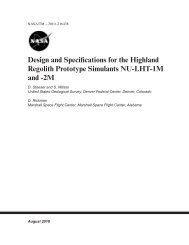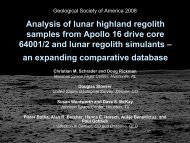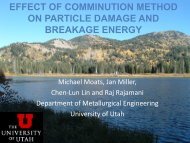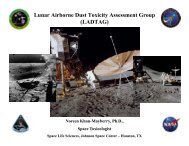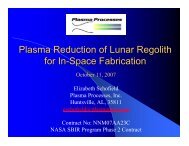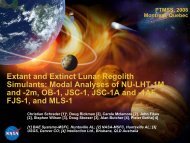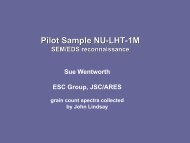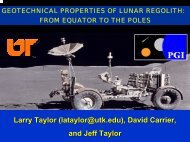Book of Abstracts- Lunar Regolith Simulant Materials Workshop
Book of Abstracts- Lunar Regolith Simulant Materials Workshop
Book of Abstracts- Lunar Regolith Simulant Materials Workshop
You also want an ePaper? Increase the reach of your titles
YUMPU automatically turns print PDFs into web optimized ePapers that Google loves.
NEW LUNAR ROOT SIMULANTS: JSC-2 (JSC-1 CLONE) AND JSC-3. James L. Carter 1 , David S. McKay 2 ,<br />
Carlton C. Allen 3 , Lawrence A. Taylor 4 ; 1 Department <strong>of</strong> Geology, University <strong>of</strong> Texas at Dallas, Richardson, TX<br />
75083-0688 (jcarter@utdallas.edu),<br />
2 Planetary Exploration, Johnson Space Center, Houston, TX 77058<br />
(david.s.mckay@nasa.gov), 3 NASA Johnson Space Center, Houston, TX 77058 (carlton.c.allen@nasa.gov), and<br />
4 Planetary Geosciences Institute, University <strong>of</strong> Tennessee, Knoxville, TN 37996 (lataylor@utk.edu).<br />
Introduction: The 2005 Marshall lunar simulant<br />
workshop builds on a workshop held in 1991 [1] to<br />
evaluate the status <strong>of</strong> simulated lunar material and to<br />
make recommendations on future requirements and<br />
production <strong>of</strong> such material based on the experiences<br />
over the past decade using the resultant simulant, JSC-<br />
1. As an outgrowth <strong>of</strong> the original workshop, a group<br />
centered at Johnson Space Center headed by David<br />
McKay and Carlton Allen teamed with James Carter <strong>of</strong><br />
the University <strong>of</strong> Texas at Dallas and Walter Boles <strong>of</strong><br />
Texas A&M University to produce and distribute a<br />
new standardized lunar soil simulant termed JSC-1.<br />
James Carter supervised the field collection, shipping,<br />
field processing, homogenization, initial packaging,<br />
transportation, and laboratory documentation <strong>of</strong> JSC-1.<br />
About 25 tons <strong>of</strong> relatively homogeneous simulant<br />
were created and ultimately distributed to the lunar<br />
science and engineering community, the academic<br />
community, museums, and individuals. JSC-1 is now<br />
essentially depleted and none is left for distribution;<br />
therefore, a replacement <strong>of</strong> JSC-1 is needed. It was<br />
proposed at the 6th Space Resources Utilization<br />
Roundtable that both a lunar maria and a lunar highland<br />
simulant be made in large quantities (100 tons<br />
minimum) [2].<br />
JSC-1: The JSC-1 lunar maria regolith fines simulant<br />
developed a decade ago served an important role<br />
in concepts and designs for lunar base and lunar materials<br />
processing. The basic parameters <strong>of</strong> JSC-1 are<br />
described by McKay et al. [3]. Its geotechnical properties<br />
are described by Klosky et al. [4]. While other<br />
lunar soil simulants were produced before JSC-1 [5],<br />
they were not standardized, and results from tests performed<br />
on them were not necessarily equivalent to test<br />
results performed on other simulants. JSC-1 was designed<br />
to be chemically similar to a low titanium lunar<br />
mare soil, have a maximum grain size <strong>of</strong> 1 mm (with<br />
50% less than 0.1 mm), a grain size distribution similar<br />
to sub-mature lunar mare regolith fines, and contain a<br />
mixture <strong>of</strong> lithic fragments, mineral fragments, and<br />
irregular vesicular glassy particles. The glass-rich<br />
character and grain size distribution <strong>of</strong> JSC-1 produced<br />
quite different properties compared to other simulants<br />
that were made entirely <strong>of</strong> comminuted solid rock.<br />
These properties closely duplicated lunar maria near<br />
surface regolith.<br />
Standardized Root <strong>Simulant</strong>: At the 6th Space<br />
Resources Utilization Roundtable the concept <strong>of</strong> a<br />
standardized root simulant was proposed in which<br />
large quantities <strong>of</strong> a lunar regolith simulant (100 tons<br />
minimum) would be produced in a manner that homogenizes<br />
it so that all sub-samples would be equivalent<br />
[2]. A standardized root simulant would be similar<br />
chemically and mineralogically, along with grain components<br />
and grain size distribution, to the lunar regolith<br />
it was chosen to simulate. Specialized properties<br />
would be difficult and, therefore, probably too<br />
expensive to be produce in large enough volumes to be<br />
incorporated in the root simulant. From a root simulant,<br />
however, other more specialized simulants could<br />
be made in small volumes to closely approximate certain<br />
properties <strong>of</strong> lunar regolith needed for specific<br />
tests and experiments. Examples include the addition<br />
<strong>of</strong> various components such as ilmenite, metallic iron,<br />
carbon, organics, or halogens, the implantation <strong>of</strong> solar<br />
wind, or the addition <strong>of</strong> ice in various proportions. In<br />
all cases, the specialized simulant would be traceable<br />
to the root simulant and so designated. Moreover, finer<br />
fractions or coarser fractions <strong>of</strong> a root simulant could<br />
be made relatively easily. The specialized simulant<br />
would be labeled so as to avoid any confusion; for<br />
example, JSC-2i, JSC-2f, and JSC-2c, for ilmenite<br />
enriched, fine fraction, and coarse fraction, respectively,<br />
<strong>of</strong> JSC-2.<br />
Mare Root <strong>Simulant</strong> (JSC-2). We propose that the<br />
new mare regolith root simulant be a clone <strong>of</strong> JSC-1<br />
and labeled JSC-2. This is because <strong>of</strong> the large body <strong>of</strong><br />
data that has been generated on JSC-1, which can be<br />
used for reference and comparison purposes. Even<br />
though it may be impossible to duplicate JSC-1 exactly,<br />
it can be duplicated closely.<br />
Root Highland <strong>Simulant</strong> (JSC-3). While JSC-1 and<br />
its clone, JSC-2, are a mare simulant, a root highland<br />
simulant may be desirable [2, 6]. Many <strong>of</strong> the proposed<br />
landing sites are in highland terrain, and the<br />
properties <strong>of</strong> lunar highland regolith have some fundamental<br />
differences compared to mare regolith. Consequently,<br />
it may be important to produce a root highland<br />
simulant and labeled JSC-3. However, this simulant<br />
probably would not have a vesicular glassy component<br />
similar to lunar agglutinates, because <strong>of</strong> the<br />
lack <strong>of</strong> appropriate vesicular volcanic materials on<br />
earth and the technical difficulties and expense re-<br />
10



